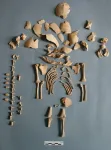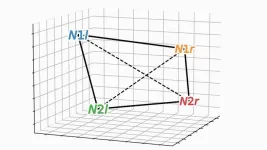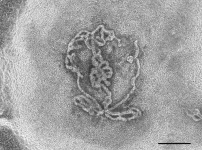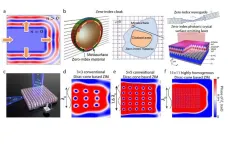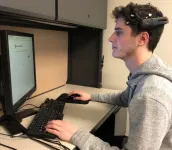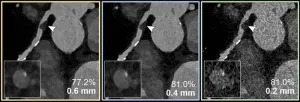Ancient genomes reveal Down Syndrome in past societies
Burials show that children with Down Syndrome and Edwards Syndrome were recognized as members of their communities
2024-02-20
(Press-News.org)
For many years, researchers at MPI-EVA have been collecting and analyzing ancient DNA from humans who lived during the past tens of thousands of years. Analyzing these data has allowed the researchers to trace the movement and mixing of people, and even to uncover ancient pathogens that affected their lives. However, a systematic study of uncommon genetic conditions had not been attempted. One of those uncommon conditions, known as Down Syndrome, affects nowadays around one in 1,000 births.
To their surprise, Adam “Ben” Rohrlach and colleagues identified six individuals with an unusually high number of DNA sequences from Chromosome 21 that could only be explained by an additional copy of Chromosome 21. One case from a church graveyard in Finland was dated to the 17th to 18th century. The remaining five individuals were much older: dating to between 5,000 and 2,500 years before present, they were found at Bronze Age sites in Greece and Bulgaria, and Iron Age sites in Spain. In all cases, the researchers were able to obtain a wealth of additional information about the remains and the burials.
Burials within settlements and with grave goods
While individuals with Down Syndrome can live a long life today, often with the help of modern medicine, this was not the case in the past. Indeed, age estimates from skeletal remains showed that all six individuals died at a very young age, with only one child reaching around one year of age. The five prehistoric burials were all located within settlements and in some cases accompanied by special items such as coloured bead necklaces, bronze rings or sea-shells. “These burials seem to show us that these individuals were cared for and appreciated as part of their ancient societies,” says Rohrlach, the lead author of the study.
Although the study was aimed at finding cases of Down Syndrome, the researchers also discovered an individual with a different condition. Among the approximately 10,000 tested DNA samples, one individual had an unexpectedly high fraction of ancient DNA sequences from Chromosome 18 that showed that she carried three copies of this chromosome. Three copies of Chromosome 18 are known to cause Edwards Syndrome, a condition associated with more severe health issues than Down syndrome. With an incidence of less than one case in 3,000 births, Edwards Syndrome also occurs much less often than Down Syndrome. This find, too, was made at one of the Spanish Iron Age sites, leaving the researchers with a mystery to solve. “At the moment, we cannot say why we find so many cases at these sites,” says Roberto Risch, an archaeologist of the Universitat Autònoma de Barcelona working on intramural funerary rites, “but we know that they belonged to the few children who received the privilege to be buried inside the houses after death. This already is a hint that they were perceived as special babies.”
As the number of DNA samples from ancient individuals continues to increase, the authors plan to further expand their research in the future. “What we would like to learn is how ancient societies reacted to individuals that may have needed a helping hand or were simply a bit different,” says Kay Prüfer, who coordinated the sequence analysis.
END
ELSE PRESS RELEASES FROM THIS DATE:
2024-02-20
NEW YORK, NY — The human brain has the extraordinary ability to rapidly discern a stranger from someone familiar, even as it can simultaneously remember details about someone across decades of encounters. Now, in mouse studies, scientists at Columbia's Zuckerman Institute have revealed how the brain elegantly performs both tasks.
“These findings are the first evidence that a single population of neurons can use different codes to represent novel and familiar individuals,” said co-corresponding author Stefano Fusi, PhD, professor of neuroscience at Columbia’s Vagelos College of Physicians and ...
2024-02-20
Kale fans can rest easy knowing pesticides used to grow the hearty greens are unlikely to end up in their salads or smoothies, a new chemical analysis of the superfood suggests.
Conducting novel tests that provide the most complete picture to date of a crop’s chemical makeup, the Johns Hopkins–led team found several pesticides and compounds in Maryland-farmed kale—but no cause for alarm.
“We do see minute traces of pesticides in the kale, but the levels we found are so much lower ...
2024-02-20
Key takeaways
A UCLA-led research team found a correlation between certain aspects of early puberty in first-born daughters and high levels of prenatal stress in their mothers.
The researchers did not find the same result in boys or in daughters who were not first-born.
This early maturation may enable a first-born daughter to help her mother rear her other children successfully, according to UCLA anthropologist Molly Fox.
A UCLA-led team of researchers has found a correlation between early signs of adrenal puberty in first-born daughters ...
2024-02-20
The testis is responsible for sperm production and testosterone synthesis. Abnormalities in testis development and function lead to disorders of sex development (DSD) and male infertility. Currently, no in vitro system exists for modeling the testis.
Dr. Nitzan Gonen, a researcher specializing in the process of fetal sex determination, together with research students Aviya Stopel, Cheli Lev and Stav Dahari, has succeeded in creating "laboratory testicles" that may significantly advance understanding of the mechanisms involved in sex determination and provide solutions for male infertility, which affects one in 12 men worldwide.
The artificial testicles ...
2024-02-20
In the realm of materials science, electromagnetic (EM) metamaterials have emerged as a revolutionary class of engineered composites capable of manipulating electromagnetic waves in ways never before possible. Unlike their naturally occurring counterparts, EM metamaterials derive their extraordinary properties from their unique structural arrangements, allowing them to exhibit unattainable electromagnetic characteristics in conventional materials.
One of the most fascinating characteristics of EM metamaterials lies in the realm of zero-index metamaterials (ZIMs). ZIMs possess the ...
2024-02-20
BLOOMINGTON, Ind. – In the classic Disney film “Beauty and the Beast,” Lumière, the candelabra character, famously sings with Mrs. Potts, a tea pot, “Be our guest, be our guest. Put our service to the test. Tie your napkin round your neck, Cherie, and we provide the rest.”
When the 1991 Oscar-nominated song co-written by Indiana University alumnus Howard Ashman was released, it hardly seemed realistic that a product could sing its own praises and sell itself to consumers. But artificial intelligence today makes ...
2024-02-20
OAK BROOK, Ill. – Ultrahigh-spatial-resolution photon-counting detector CT improved assessment of coronary artery disease (CAD), allowing for reclassification to a lower disease category in 54% of patients, according to a new study published today in Radiology, a journal of the Radiological Society of North America (RSNA). The technology has the potential to improve patient management and reduce unnecessary interventions.
Coronary CT angiography is a first-line test in the assessment of coronary artery disease. However, its diagnostic value is limited in patients with severe calcifications, or calcium ...
2024-02-20
OAK BROOK, Ill. – Annual breast cancer screening beginning at age 40 and continuing to at least age 79 results in the highest reduction in mortality with minimal risks, according to a new study published today in Radiology, a journal of the Radiological Society of North America (RSNA).
Breast cancer is the second most common cause of cancer death for women in the U.S. Despite research demonstrating that consistent participation in screening mammography can reduce breast cancer deaths by 40%, only 50% or less of eligible women actually participate in annual screening.
“There is an ongoing debate over the recommendations for breast cancer screening, specifically ...
2024-02-20
Two New York University faculty have been awarded fellowships from the Alfred P. Sloan Foundation: SueYeon Chung, an assistant professor at the Center for Neural Science, and Jinyoung Park, an assistant professor at the Courant Institute for Mathematical Sciences.
The fellowships recognize “exceptional U.S. and Canadian researchers whose creativity, innovation, and research accomplishments make them stand out as the next generation of leaders,” the Sloan Foundation said in announcing this year’s ...
2024-02-20
A recent study led by Assistant Professor Lindsay Jibb of the Lawrence Bloomberg Faculty of Nursing and Scientist at The Hospital for Sick Children (SickKids) found that parents of young children with cancer, along with pediatric cancer clinicians are in favour of an app-based solution that Jibb and her team are creating, to help parents manage their child’s cancer pain at home.
The study published in PLOS Digital Health showed that parents and clinicians not only found the pain management app to be helpful and safe, but also provided them with a sense of empowerment.
“The ...
LAST 30 PRESS RELEASES:
[Press-News.org] Ancient genomes reveal Down Syndrome in past societies
Burials show that children with Down Syndrome and Edwards Syndrome were recognized as members of their communities
